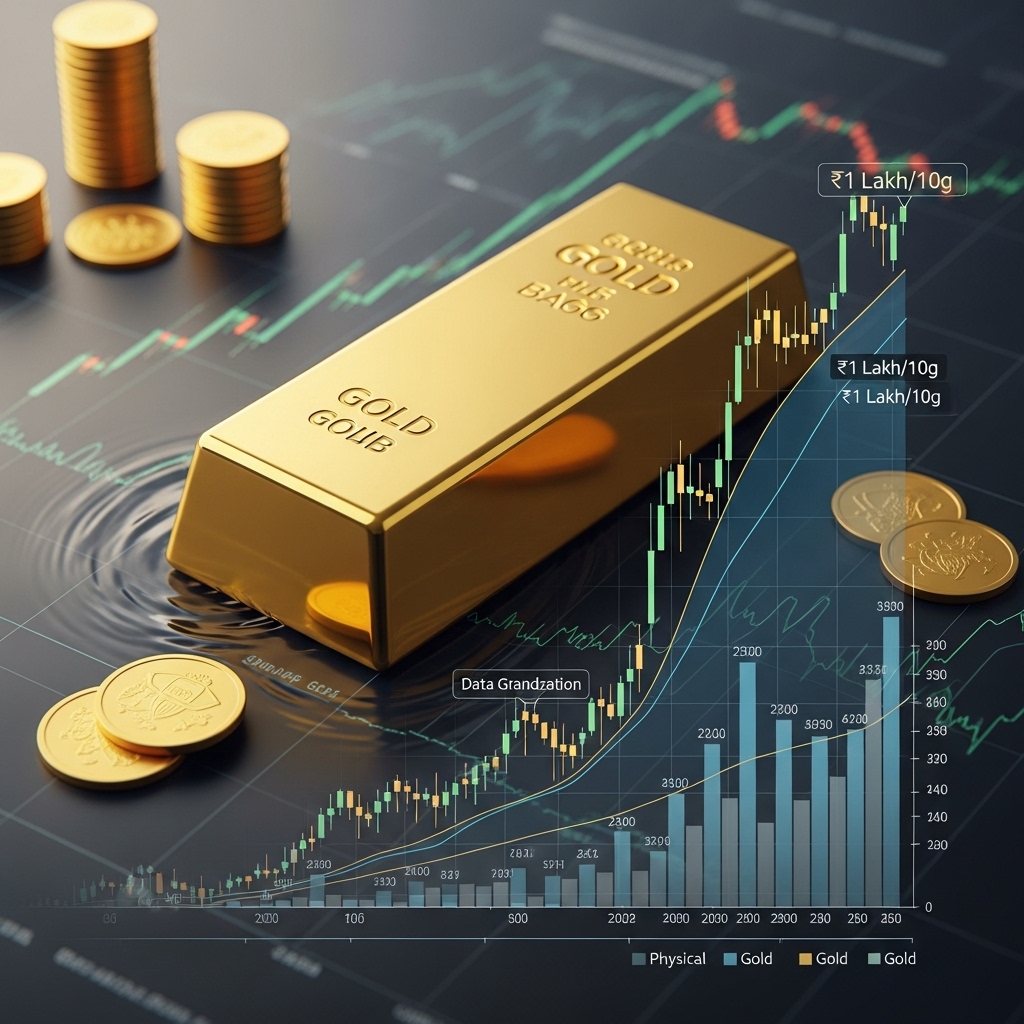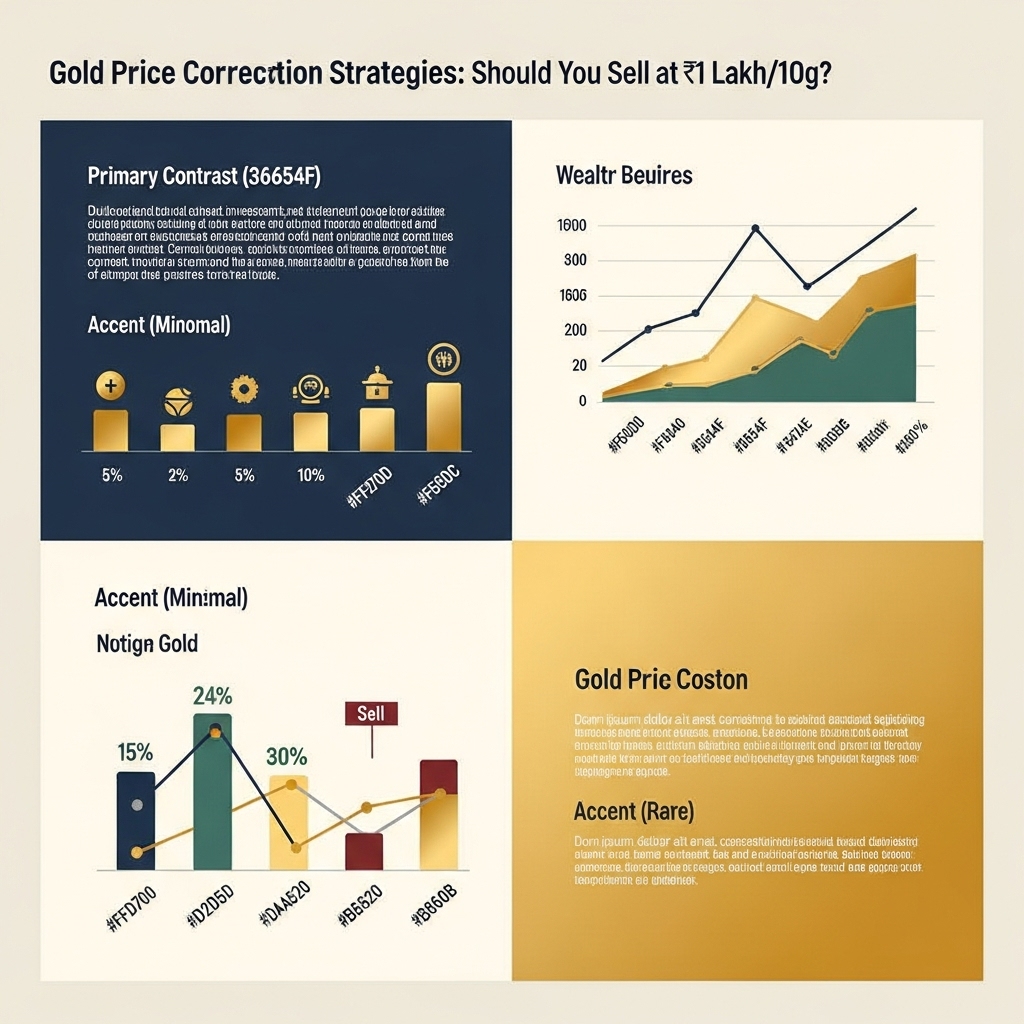Gold Price Correction Strategies: Should You Sell at ₹1 Lakh/10g?
The allure of gold as a safe-haven asset and a potent hedge against inflation remains undeniable, especially in today’s volatile economic landscape. With gold prices hovering near historical highs and whispers of ₹1 lakh per 10 grams becoming a tangible possibility, many investors are wondering: is this the opportune moment to cash in? Understanding the dynamics of gold price corrections and developing a sound strategy is paramount for maximizing your financial benefits and safeguarding your portfolio. This post delves into the critical question of whether selling your gold at this anticipated price point is a wise move, exploring the factors that influence gold prices and outlining strategic approaches for navigating potential downturns.
This article will equip you with the knowledge to make informed decisions regarding your gold investments. We’ll examine the current market trends driving gold’s ascent, analyze the economic indicators that could signal a correction, and discuss various strategies for managing your gold holdings during such periods. From understanding profit-taking triggers to exploring diversification options, we’ll cover what matters most for savvy gold investors looking to optimize their returns while mitigating risk.
The prospect of achieving ₹1 lakh per 10 grams of gold is exciting, but it also presents a crucial juncture for many. Without a well-defined strategy, the temptation to sell impulsively at a peak can lead to missed opportunities or, conversely, holding on too long and watching profits diminish. By understanding the nuances of gold price movements and employing thoughtful correction strategies, you can confidently navigate the market and ensure your gold investments continue to serve your long-term financial goals.
Gold Market Analysis and Key Insights
Gold has historically served as a critical asset, particularly during economic volatility. As the yellow metal potentially approaches the significant ₹1 lakh/10g mark, a comprehensive understanding of market dynamics is crucial for investors contemplating their next move.
Global Economic Uncertainty and Inflationary Pressures
A primary driver for gold’s upward trajectory is persistent global economic uncertainty and elevated inflation concerns. Investors increasingly seek gold as a hedge against purchasing power erosion, seeing it as a reliable store of value. High inflation often diminishes real returns on other assets, significantly boosting gold’s appeal.
Central Bank Policies and Interest Rates
Central bank interest rate stances significantly impact gold prices. While higher rates typically make non-yielding assets like gold less attractive due to increased opportunity cost, a dovish stance or expected rate cuts can boost its appeal. Market sentiment, balancing inflation control and economic growth, heavily influences gold’s performance.
Geopolitical Landscape and Safe-Haven Demand
Escalating geopolitical tensions and global instability invariably fuel safe-haven demand for gold. In times of crisis, investors flock to gold, perceiving it as a secure asset that retains value when other markets are volatile. This flight to safety contributes significantly to price surges, independent of pure economic indicators.
Currently, the gold market reflects strong underlying demand, propelled by ongoing inflationary pressures, a softening interest rate outlook, and persistent geopolitical instability. Data shows gold consistently breaking new nominal highs. The ₹1 lakh/10g threshold represents a significant psychological level, prompting investors to reassess their positions.
From an investment perspective, gold offers portfolio diversification and acts as an excellent hedge against currency depreciation and inflation. However, it yields no dividends or interest, and physical gold incurs storage costs. The decision to sell at ₹1 lakh/10g should align with individual financial goals, risk tolerance, and portfolio rebalancing needs, not solely on hitting an arbitrary number. It could be an opportune moment to book partial profits for some, while long-term holders might retain it for further appreciation given its historical resilience.
Expert recommendations generally advocate for a balanced approach. Diversification across asset classes remains paramount. Investors should consider taking partial profits if gold constitutes an outsized portion of their portfolio or if immediate financial needs arise. For long-term investors, continuing to hold gold for its strategic benefits, especially against ongoing economic uncertainties, is often advised. Systematic investment strategies can help mitigate market timing risks.

Gold Investment Strategies and Options
Navigating gold price corrections, especially at a psychologically significant level like ₹1 Lakh/10g, demands a clear investment strategy. Gold historically serves as a vital portfolio diversifier and a hedge against inflation and geopolitical uncertainty, making its role in a well-rounded investment plan critical.
Key gold investment options include physical gold (bars, coins), offering tangible ownership but incurring storage, insurance, and potential purity verification costs. Gold Exchange Traded Funds (ETFs) provide a more liquid, convenient, and cost-effective way to gain exposure to gold prices without the physical asset’s drawbacks. For long-term investors, Sovereign Gold Bonds (SGBs) stand out, offering annual interest, government-backed safety, and tax exemptions on maturity, though they come with a lock-in period. Digital gold platforms also offer fractional ownership with ease of access.
Comparing these methods reveals distinct trade-offs: physical gold’s perceived safety versus ETFs’ liquidity and SGBs’ unique tax and interest benefits. Risk assessment suggests gold allocation typically ranges from 5-15% of a diversified portfolio, primarily as a defensive asset rather than for aggressive growth. This allocation aims to stabilize returns during market volatility in other asset classes, reducing overall portfolio risk.
Market timing is crucial but challenging. A price of ₹1 Lakh/10g might prompt profit-booking for short-term traders, while long-term investors might hold, anticipating further appreciation, or rebalance their holdings. Instead of attempting to predict market peaks or troughs, consider a Dollar-Cost Averaging (DCA) approach for purchases to mitigate entry timing risk. Selling decisions should align with personal financial goals – whether it’s rebalancing, funding other investments, or realizing gains. Always consider macro-economic factors like interest rate trends, inflation outlook, and global stability before making significant moves.
Market Performance and Outlook
Gold’s journey to current levels, flirting with the ₹1 Lakh/10g mark, is underpinned by a robust historical performance. Over the past few years, gold has demonstrated its resilience, particularly during periods of economic uncertainty and elevated inflation. Post-pandemic, it surged, establishing new all-time highs as investors sought a safe haven against unprecedented fiscal stimulus and supply chain disruptions. This sustained rally highlights gold’s role as an inflation hedge and a store of value, often thriving when traditional assets face headwinds.
Currently, the market is characterized by high volatility around these psychological price points. While strong demand persists, particularly from central banks, the upward momentum is often tested by profit-booking. Future outlook remains complex. Many analysts predict continued long-term appreciation due to persistent geopolitical tensions, de-dollarization trends, and ongoing inflationary pressures. However, potential corrections are anticipated if global interest rates remain high or rise further, as higher yields on fixed-income assets can diminish gold’s appeal (which offers no yield). Conversely, a weakening US Dollar or any fresh economic instability could propel prices even higher. Investors must weigh these dynamic economic factors – inflation, interest rates, and global stability – against gold’s intrinsic value and its historical role as a crisis commodity when deciding on correction strategies.
Frequently Asked Questions About Gold Investment
Should I sell all my gold if prices reach ₹1 Lakh/10g?
Selling depends on your individual financial goals, liquidity needs, and original purchase price. Reaching ₹1 Lakh/10g might signal a good opportunity to book profits, especially if you have an immediate need for funds or believe a correction is imminent. However, it’s rarely advisable to sell all your gold, as it serves as a long-term hedge against inflation and economic uncertainty.
What does ‘gold price correction’ actually mean?
A gold price correction refers to a significant, usually short-term, drop in its price after a period of sustained gains. It’s a natural market phenomenon where prices adjust downwards from a peak, often due to profit-taking by investors or a shift in economic sentiment (e.g., rising interest rates, stronger equity markets).
What key factors should I consider before selling gold?
Consider your original purchase price (cost basis), your investment horizon, whether you need the liquidity for other financial goals (e.g., debt repayment, a major purchase), and your belief in gold’s future trajectory. Also, be mindful of potential capital gains tax implications on your profits.
Are there alternatives to outright selling during a price surge?
Yes. You could consider selling only a portion of your gold to book partial profits while retaining some exposure to the metal. Another option for liquidity is taking a gold loan, using your gold as collateral without selling it, though this involves interest payments.
How can I assess if ₹1 Lakh/10g is a ‘good’ selling price for me?
It’s a ‘good’ price if it helps you achieve a specific financial goal or if you’ve already made substantial profits and wish to rebalance your investment portfolio. Calculate your returns based on your average purchase price. Your personal financial situation, risk appetite, and investment strategy are key determinants.

Final Thoughts on Gold Investment
As we’ve explored, navigating gold price corrections, even as the ₹1 Lakh/10g mark approaches, demands a strategic, not emotional, approach. Key takeaways include understanding gold’s role as a long-term diversifier, the normalcy of market corrections, and the importance of aligning decisions with your personal financial goals. Panicking or selling based solely on a round number can be detrimental.
Our final recommendation for most investors is to resist the urge for knee-jerk selling. Instead, view potential corrections as opportunities for rebalancing or even strategic accumulation if it fits your portfolio. Continuously assess your allocation and overall financial plan. Don’t let a psychological price point dictate your long-term financial well-being. Review your portfolio, seek professional financial advice, and make informed decisions that serve your unique investment journey.